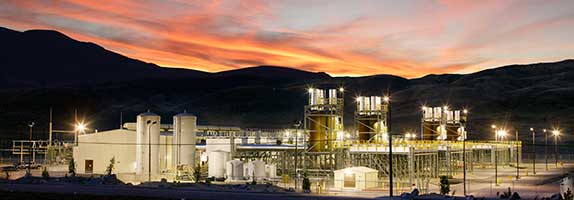

About Marine
Wärtsilä Corporation, Wednesday 14th September 2022 at 10:00 Philippines Standard Time.
Power system modelling by the global technology group Wärtsilä has revealed that renewable-based power systems, backed by grid balancing engines and energy storage, would enable the Philippines to reach net zero by 2050, whilst cutting the levelised cost of electricity (LCOE) by more than 20% when accounting for likely future carbon taxes.
Wärtsilä’s modelling of the power system of the Philippines’ largest island, Luzon, shows that a combination of renewables plus flexibility, provided by balancing engines and energy storage, can reliably meet the region’s increasing power demand.
Wärtsilä modelled two different scenarios: the “Business As Usual” (BAU) scenario – without an emissions limit – and a “Net Zero” scenario, where emissions were halved by 2040, before reaching net zero by 2050. Critically, when factoring in the International Energy Agency’s (IEA)’s upper forecasted carbon prices , the study shows that the LCOE in the “Net Zero” scenario is 23% lower than in the “Business As Usual” (BAU) scenario. This would equate to an annual saving of $6.5 billion USD.
Luzon: A critical region for the Philippines’ energy transition:
Luzon represents around 72% of the Philippines’ total energy generation and around 72% of the Philippines’ peak demand , compared to 14% in Visayas and 13% in Mindanao. The modelled pathway for Luzon, published in the Rethinking Energy in Southeast Asia report, can serve as a blueprint for major islands in the regions of Visayas and Mindanao as well.
The Philippines has not yet explicitly communicated a net zero target, but its National Renewable Energy Program (NREP) sets out plans to power the grid with a 35% share of renewables by 2030 and 50% by 2040 .
The modelled scenarios reveal that flexibility, in the form of energy storage and balancing engines, is the crucial technological fix to enable renewable energy to become the dominant source of power. To put Luzon on course for its target of 35% renewables by 2030 and 50% by 2040, the island’s power system needs to rapidly accelerate the adoption of flexible balancing power plants, with 1.3 GW needed by 2030. By 2050, 14 GW of balancing power plants and 69 GW of energy storage would be required in Luzon’s power sector to achieve net zero emissions.
Key findings:
With the right mix of balancing technology and renewables, Luzon can double the renewable generation in comparison to the “BAU” scenario, from 34% to 67% by 2040.
By 2050, renewables can reliably provide 87% of Luzon’s total generation, up from 18% in 2020. Optimally, this renewable generation comes from 141 GW solar and 33 GW wind.
David Kayanan, Financial & Market Analyst, Wärtsilä Energy, said:
“The results of the study clearly show that the opportunity of a generation is in reach for the Philippines’ energy leaders. In the Philippines, renewables can be levelled up using flexible capacity to serve the current load, while comfortably meeting rising power demand, and decarbonising at the lowest cost.
“As countries return to the climate negotiations table at COP27, it’s clear that a net zero commitment in the Philippines would send a strong signal to investors, helping the country attract the needed investment to achieve this transition. On the flip side, without a net zero goal, the Philippines risks detaching itself from an increasingly climate-conscious global community and worsening its own exposure to climate change.”
“We hope that our report serves to assure energy leaders that, by creating a renewable and dynamic power system, the Philippines can increase energy self-sufficiency and mitigate climate risks, with the power sector continuing to support the economic development of the country."
The study results, published in the Rethinking Energy in Southeast Asia report, simulate the paths to net zero emissions in three major Southeast Asian power systems: Vietnam; the island of Sulawesi in Indonesia; and the island of Luzon in the Philippines.
[1] Savings in excess of 20% are calculated when factoring in the IEA’s predicted carbon prices, as set out in World Energy Outlook (2021). https://iea.blob.core.windows.net/assets/4ed140c1-c3f3-4fd9-acae-789a4e14a23c/WorldEnergyOutlook2021.pdf
[2] Peak demand was 11.1 GW of 15.3 GW in 2020.
[3] https://www.doe.gov.ph/sites/default/files/pdf/announcements/nrep_2020-2040.pdf?withshield=1
© Wärtsilä Corporation
Media contact for more information on this release:
Kari Punnonen
Energy Business Director, Australasia
Wärtsilä Energy
Mob: +65 81256753
kari.punnonen@wartsila.com
All Wärtsilä releases are available at https://www.wartsila.com/media/news-releases and at http://news.cision.com/wartsila-corporation where also the images can be downloaded.
Wärtsilä Energy in brief
Wärtsilä Energy leads the transition towards a 100% renewable energy future. We help our customers in decarbonisation by developing market-leading technologies. These cover future-fuel enabled balancing power plants, hybrid solutions, energy storage and optimisation technology, including the GEMS energy management platform. Wärtsilä Energy’s lifecycle services are designed to increase efficiency, promote reliability and guarantee operational performance. Our track record comprises 76 GW of power plant capacity and 110 energy storage systems delivered to 180 countries around the world.
https://www.wartsila.com/energy
Wärtsilä in brief
Wärtsilä is a global leader in innovative technologies and lifecycle solutions for the marine and energy markets. We emphasise innovation in sustainable technology and services to help our customers continuously improve their environmental and economic performance. Our dedicated and passionate team of 17,000 professionals in more than 200 locations in 68 countries shape the decarbonisation transformation of our industries across the globe. In 2021, Wärtsilä’s net sales totalled EUR 4.8 billion. Wärtsilä is listed on Nasdaq Helsinki.
www.wartsila.com